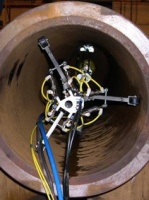Babcock develops inspection technique for naval ships
Babcock International has developed a new non-destructive testing (NDT) technique for naval ship tailshafts that could reduce assessment time from 18 weeks to one month.
After being qualified for use last year, the technique will be applied next month for the first time on Trafalgar class submarine HMS Trenchant during the current Revalidation and Maintenance Period (RAMP) being undertaken by Babcock at Devonport Royal Dockyard.

Tailshafts require a rigorous inspection regime for potential corrosion-initiated fatigue cracking. Such cracking can be caused by sea water seeping beneath the tailshaft’s protective glass reinforced plastic (GRP) layer.
Up until now there has been no way to guarantee tailshaft integrity other than removing it, machining off the GRP bandage and subsequently surveying it.
The new technique enables the tailshaft to be inspected from the inside. Using an access point at the outboard end of the shaft, engineers found a way to feed in a transducer carrier with ultrasonic probes.
Register now to continue reading
Thanks for visiting The Engineer. You’ve now reached your monthly limit of news stories. Register for free to unlock unlimited access to all of our news coverage, as well as premium content including opinion, in-depth features and special reports.
Benefits of registering
-
In-depth insights and coverage of key emerging trends
-
Unrestricted access to special reports throughout the year
-
Daily technology news delivered straight to your inbox










UK Enters ‘Golden Age of Nuclear’
Anybody know why it takes from 2025 to mid 2030's to build a factory-made SMR, by RR? Ten years... has there been no demonstrator either? Do RR...